Case Study: BP in Russia - Partnerships and Competitive Advantage
VerifiedAdded on 2022/10/31
|13
|3319
|346
Case Study
AI Summary
This case study examines the strategic challenges faced by British Petroleum (BP) in Russia, focusing on the complexities of forming and managing international partnerships within the Russian oil and gas market. The analysis delves into the issues arising from BP's collaborations with entities like Alpha Access, Rosneft, and TNK, highlighting the impact of HRM policies, organizational instability, and the unique structure of the Russian oil industry. The report identifies key strategic issues, including ineffective partnerships, talent management challenges, and legal disputes stemming from conflicting interests and government regulations. It applies various theoretical concepts of business strategy, such as strategic positioning and alliance management, to evaluate BP's approach. The study emphasizes the need for BP to carefully assess the Russian business environment, manage stakeholder dynamics, and establish robust strategies to achieve competitive advantage. The conclusion suggests that BP requires substantial investments and strategic planning to fully realize its gas potential in Russia.

Running Head: MANAGEMENT 0
COMPETITIVE AND ADVANTAGE
COMPETITIVE AND ADVANTAGE
Paraphrase This Document
Need a fresh take? Get an instant paraphrase of this document with our AI Paraphraser
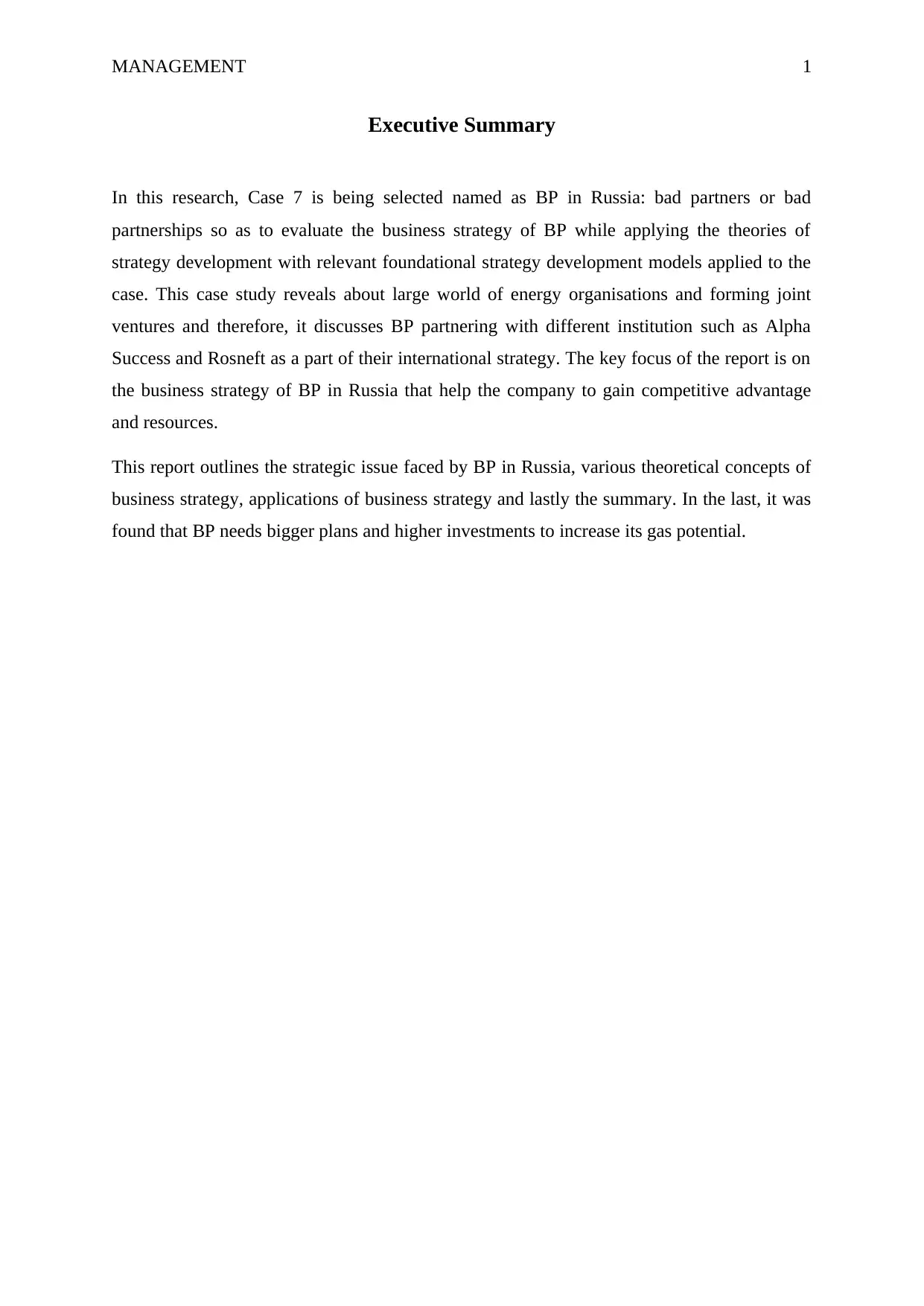
MANAGEMENT 1
Executive Summary
In this research, Case 7 is being selected named as BP in Russia: bad partners or bad
partnerships so as to evaluate the business strategy of BP while applying the theories of
strategy development with relevant foundational strategy development models applied to the
case. This case study reveals about large world of energy organisations and forming joint
ventures and therefore, it discusses BP partnering with different institution such as Alpha
Success and Rosneft as a part of their international strategy. The key focus of the report is on
the business strategy of BP in Russia that help the company to gain competitive advantage
and resources.
This report outlines the strategic issue faced by BP in Russia, various theoretical concepts of
business strategy, applications of business strategy and lastly the summary. In the last, it was
found that BP needs bigger plans and higher investments to increase its gas potential.
Executive Summary
In this research, Case 7 is being selected named as BP in Russia: bad partners or bad
partnerships so as to evaluate the business strategy of BP while applying the theories of
strategy development with relevant foundational strategy development models applied to the
case. This case study reveals about large world of energy organisations and forming joint
ventures and therefore, it discusses BP partnering with different institution such as Alpha
Success and Rosneft as a part of their international strategy. The key focus of the report is on
the business strategy of BP in Russia that help the company to gain competitive advantage
and resources.
This report outlines the strategic issue faced by BP in Russia, various theoretical concepts of
business strategy, applications of business strategy and lastly the summary. In the last, it was
found that BP needs bigger plans and higher investments to increase its gas potential.
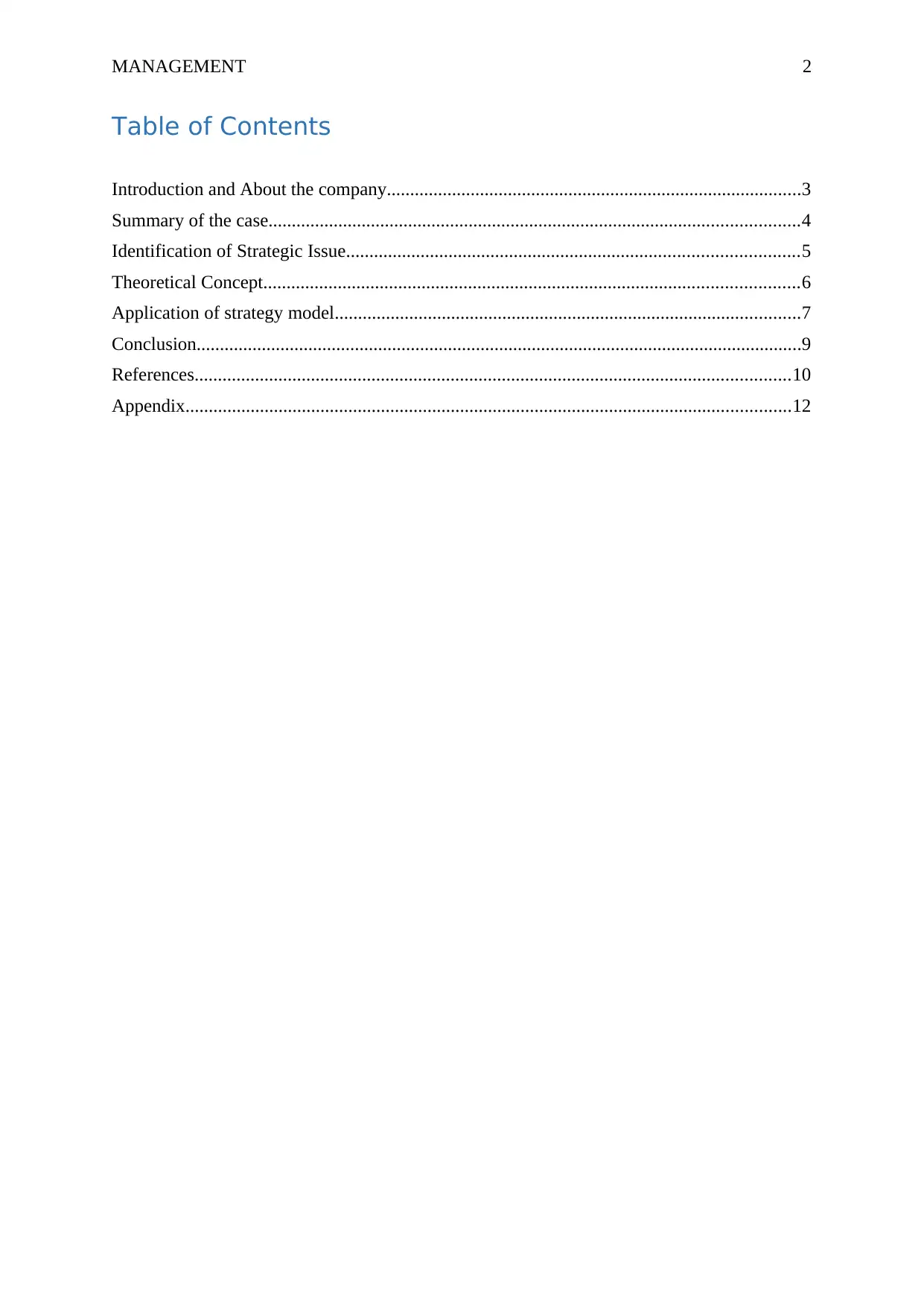
MANAGEMENT 2
Table of Contents
Introduction and About the company.........................................................................................3
Summary of the case..................................................................................................................4
Identification of Strategic Issue.................................................................................................5
Theoretical Concept...................................................................................................................6
Application of strategy model....................................................................................................7
Conclusion..................................................................................................................................9
References................................................................................................................................10
Appendix..................................................................................................................................12
Table of Contents
Introduction and About the company.........................................................................................3
Summary of the case..................................................................................................................4
Identification of Strategic Issue.................................................................................................5
Theoretical Concept...................................................................................................................6
Application of strategy model....................................................................................................7
Conclusion..................................................................................................................................9
References................................................................................................................................10
Appendix..................................................................................................................................12
⊘ This is a preview!⊘
Do you want full access?
Subscribe today to unlock all pages.

Trusted by 1+ million students worldwide
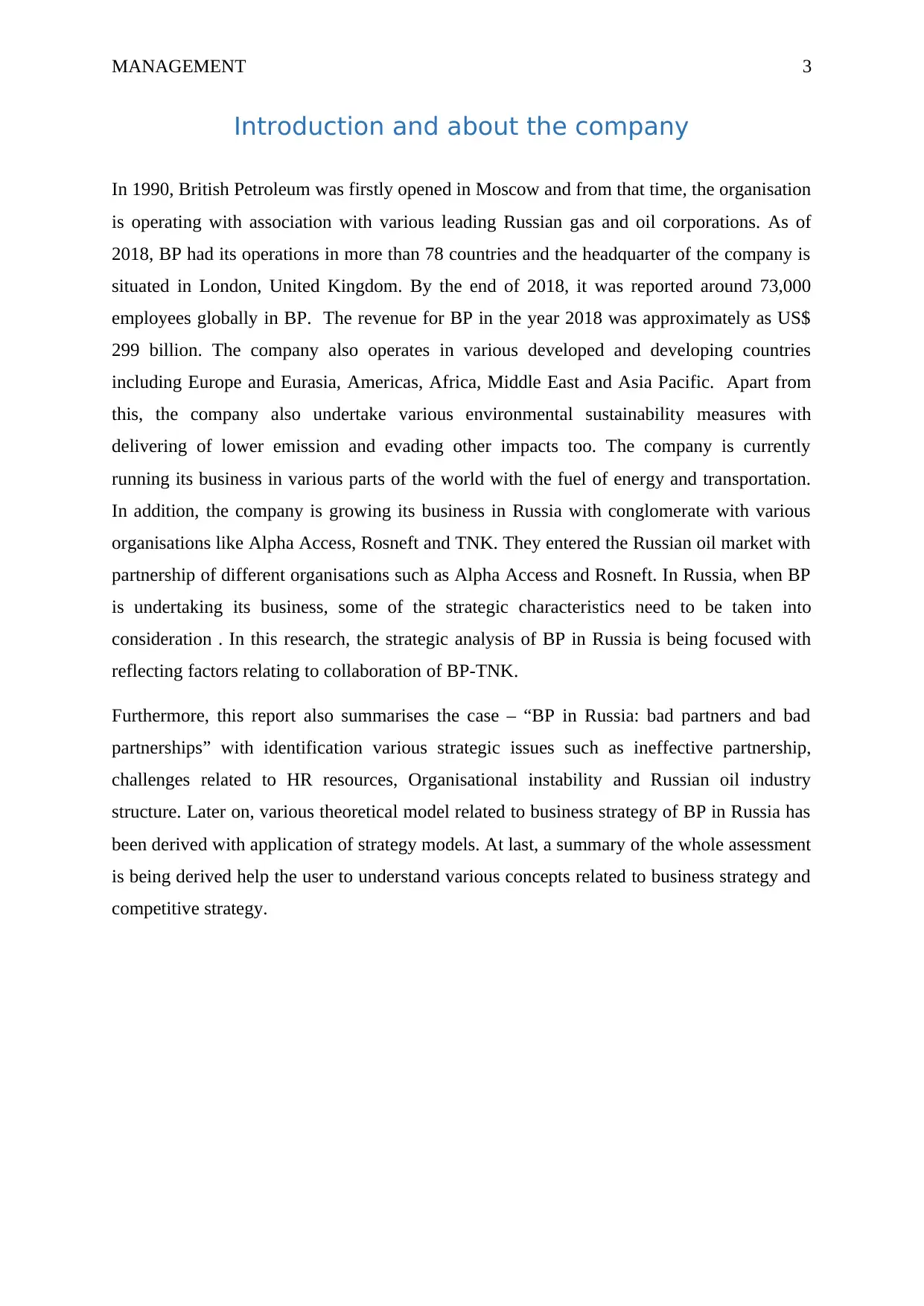
MANAGEMENT 3
Introduction and about the company
In 1990, British Petroleum was firstly opened in Moscow and from that time, the organisation
is operating with association with various leading Russian gas and oil corporations. As of
2018, BP had its operations in more than 78 countries and the headquarter of the company is
situated in London, United Kingdom. By the end of 2018, it was reported around 73,000
employees globally in BP. The revenue for BP in the year 2018 was approximately as US$
299 billion. The company also operates in various developed and developing countries
including Europe and Eurasia, Americas, Africa, Middle East and Asia Pacific. Apart from
this, the company also undertake various environmental sustainability measures with
delivering of lower emission and evading other impacts too. The company is currently
running its business in various parts of the world with the fuel of energy and transportation.
In addition, the company is growing its business in Russia with conglomerate with various
organisations like Alpha Access, Rosneft and TNK. They entered the Russian oil market with
partnership of different organisations such as Alpha Access and Rosneft. In Russia, when BP
is undertaking its business, some of the strategic characteristics need to be taken into
consideration . In this research, the strategic analysis of BP in Russia is being focused with
reflecting factors relating to collaboration of BP-TNK.
Furthermore, this report also summarises the case – “BP in Russia: bad partners and bad
partnerships” with identification various strategic issues such as ineffective partnership,
challenges related to HR resources, Organisational instability and Russian oil industry
structure. Later on, various theoretical model related to business strategy of BP in Russia has
been derived with application of strategy models. At last, a summary of the whole assessment
is being derived help the user to understand various concepts related to business strategy and
competitive strategy.
Introduction and about the company
In 1990, British Petroleum was firstly opened in Moscow and from that time, the organisation
is operating with association with various leading Russian gas and oil corporations. As of
2018, BP had its operations in more than 78 countries and the headquarter of the company is
situated in London, United Kingdom. By the end of 2018, it was reported around 73,000
employees globally in BP. The revenue for BP in the year 2018 was approximately as US$
299 billion. The company also operates in various developed and developing countries
including Europe and Eurasia, Americas, Africa, Middle East and Asia Pacific. Apart from
this, the company also undertake various environmental sustainability measures with
delivering of lower emission and evading other impacts too. The company is currently
running its business in various parts of the world with the fuel of energy and transportation.
In addition, the company is growing its business in Russia with conglomerate with various
organisations like Alpha Access, Rosneft and TNK. They entered the Russian oil market with
partnership of different organisations such as Alpha Access and Rosneft. In Russia, when BP
is undertaking its business, some of the strategic characteristics need to be taken into
consideration . In this research, the strategic analysis of BP in Russia is being focused with
reflecting factors relating to collaboration of BP-TNK.
Furthermore, this report also summarises the case – “BP in Russia: bad partners and bad
partnerships” with identification various strategic issues such as ineffective partnership,
challenges related to HR resources, Organisational instability and Russian oil industry
structure. Later on, various theoretical model related to business strategy of BP in Russia has
been derived with application of strategy models. At last, a summary of the whole assessment
is being derived help the user to understand various concepts related to business strategy and
competitive strategy.
Paraphrase This Document
Need a fresh take? Get an instant paraphrase of this document with our AI Paraphraser
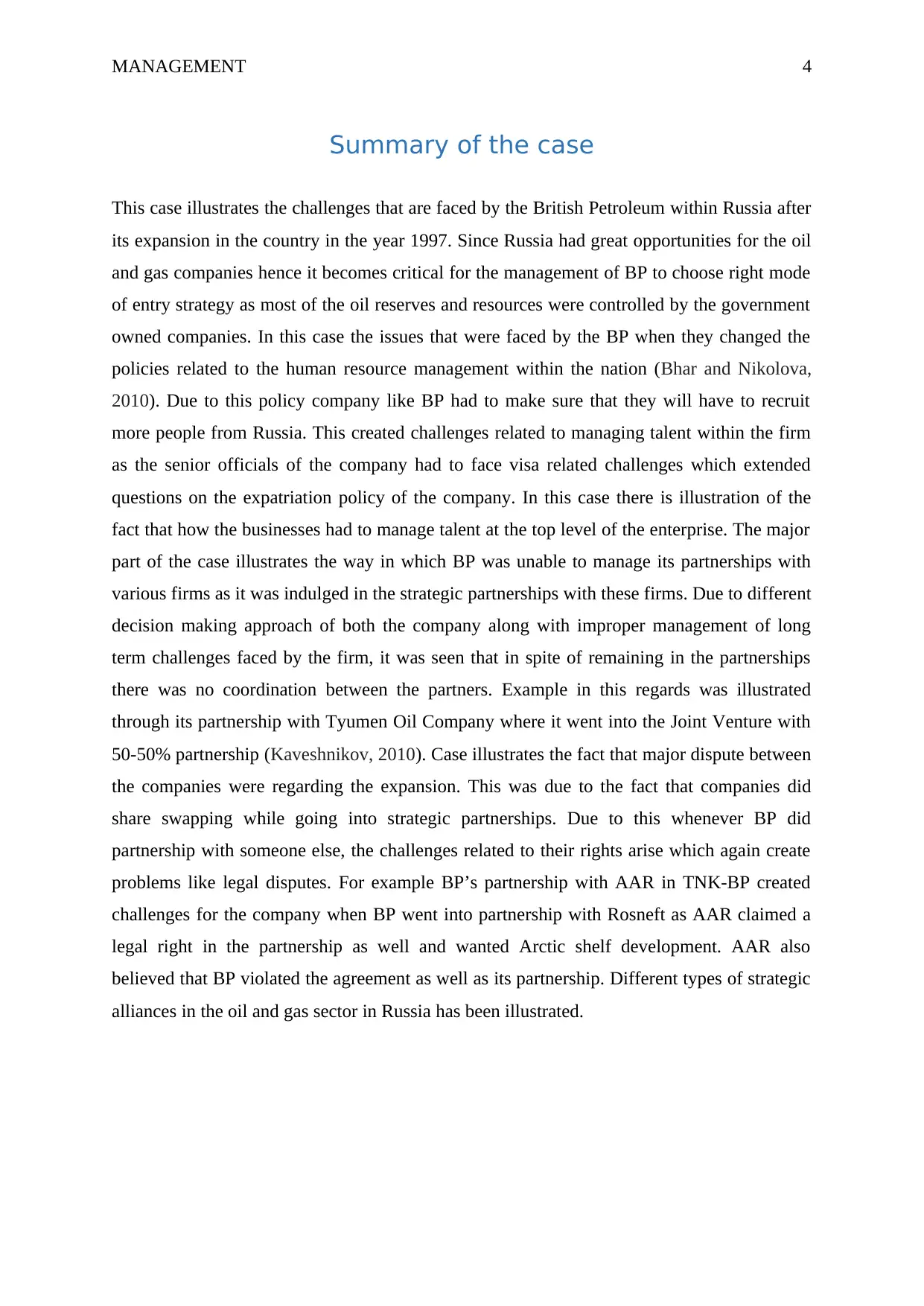
MANAGEMENT 4
Summary of the case
This case illustrates the challenges that are faced by the British Petroleum within Russia after
its expansion in the country in the year 1997. Since Russia had great opportunities for the oil
and gas companies hence it becomes critical for the management of BP to choose right mode
of entry strategy as most of the oil reserves and resources were controlled by the government
owned companies. In this case the issues that were faced by the BP when they changed the
policies related to the human resource management within the nation (Bhar and Nikolova,
2010). Due to this policy company like BP had to make sure that they will have to recruit
more people from Russia. This created challenges related to managing talent within the firm
as the senior officials of the company had to face visa related challenges which extended
questions on the expatriation policy of the company. In this case there is illustration of the
fact that how the businesses had to manage talent at the top level of the enterprise. The major
part of the case illustrates the way in which BP was unable to manage its partnerships with
various firms as it was indulged in the strategic partnerships with these firms. Due to different
decision making approach of both the company along with improper management of long
term challenges faced by the firm, it was seen that in spite of remaining in the partnerships
there was no coordination between the partners. Example in this regards was illustrated
through its partnership with Tyumen Oil Company where it went into the Joint Venture with
50-50% partnership (Kaveshnikov, 2010). Case illustrates the fact that major dispute between
the companies were regarding the expansion. This was due to the fact that companies did
share swapping while going into strategic partnerships. Due to this whenever BP did
partnership with someone else, the challenges related to their rights arise which again create
problems like legal disputes. For example BP’s partnership with AAR in TNK-BP created
challenges for the company when BP went into partnership with Rosneft as AAR claimed a
legal right in the partnership as well and wanted Arctic shelf development. AAR also
believed that BP violated the agreement as well as its partnership. Different types of strategic
alliances in the oil and gas sector in Russia has been illustrated.
Summary of the case
This case illustrates the challenges that are faced by the British Petroleum within Russia after
its expansion in the country in the year 1997. Since Russia had great opportunities for the oil
and gas companies hence it becomes critical for the management of BP to choose right mode
of entry strategy as most of the oil reserves and resources were controlled by the government
owned companies. In this case the issues that were faced by the BP when they changed the
policies related to the human resource management within the nation (Bhar and Nikolova,
2010). Due to this policy company like BP had to make sure that they will have to recruit
more people from Russia. This created challenges related to managing talent within the firm
as the senior officials of the company had to face visa related challenges which extended
questions on the expatriation policy of the company. In this case there is illustration of the
fact that how the businesses had to manage talent at the top level of the enterprise. The major
part of the case illustrates the way in which BP was unable to manage its partnerships with
various firms as it was indulged in the strategic partnerships with these firms. Due to different
decision making approach of both the company along with improper management of long
term challenges faced by the firm, it was seen that in spite of remaining in the partnerships
there was no coordination between the partners. Example in this regards was illustrated
through its partnership with Tyumen Oil Company where it went into the Joint Venture with
50-50% partnership (Kaveshnikov, 2010). Case illustrates the fact that major dispute between
the companies were regarding the expansion. This was due to the fact that companies did
share swapping while going into strategic partnerships. Due to this whenever BP did
partnership with someone else, the challenges related to their rights arise which again create
problems like legal disputes. For example BP’s partnership with AAR in TNK-BP created
challenges for the company when BP went into partnership with Rosneft as AAR claimed a
legal right in the partnership as well and wanted Arctic shelf development. AAR also
believed that BP violated the agreement as well as its partnership. Different types of strategic
alliances in the oil and gas sector in Russia has been illustrated.
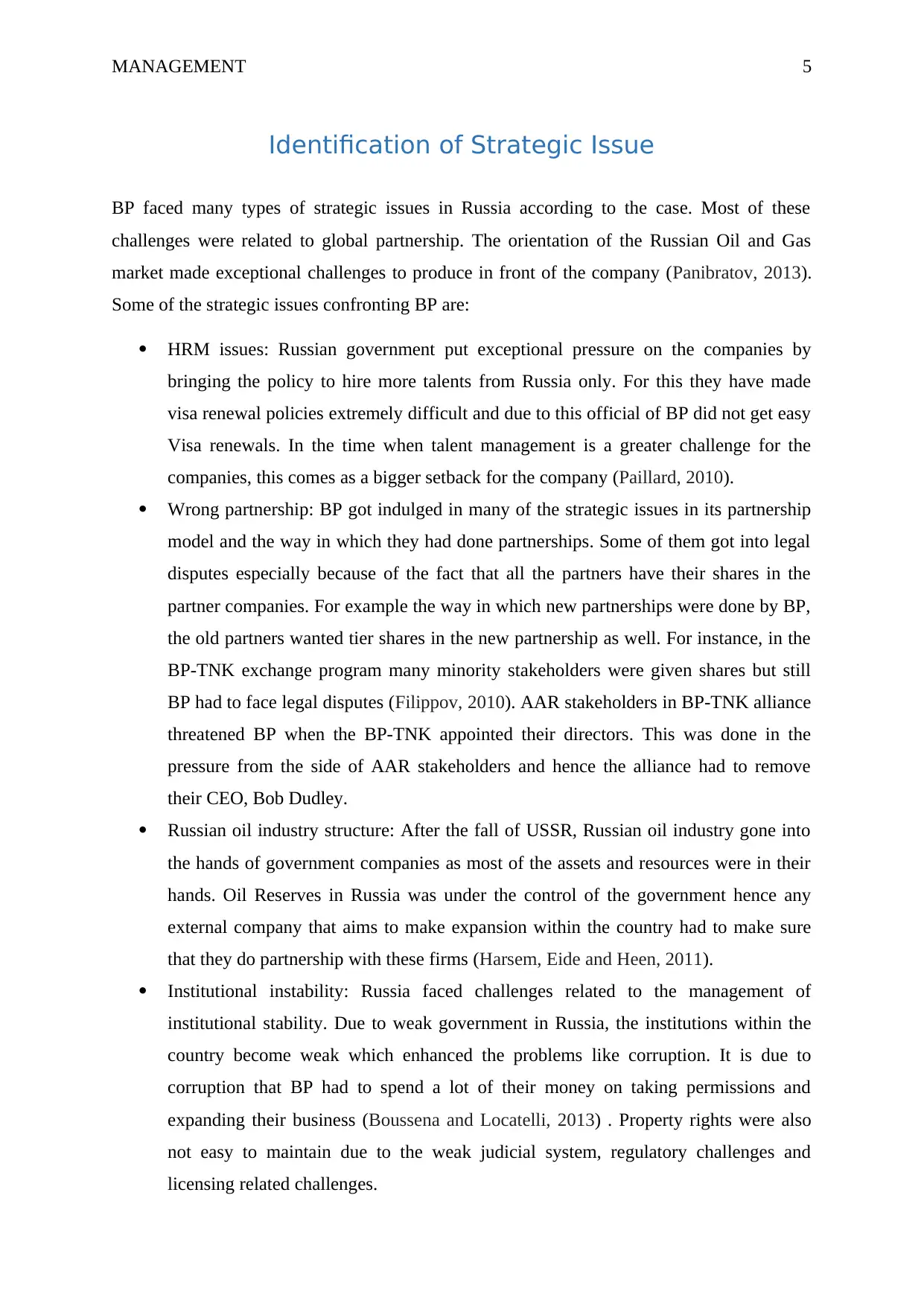
MANAGEMENT 5
Identification of Strategic Issue
BP faced many types of strategic issues in Russia according to the case. Most of these
challenges were related to global partnership. The orientation of the Russian Oil and Gas
market made exceptional challenges to produce in front of the company (Panibratov, 2013).
Some of the strategic issues confronting BP are:
HRM issues: Russian government put exceptional pressure on the companies by
bringing the policy to hire more talents from Russia only. For this they have made
visa renewal policies extremely difficult and due to this official of BP did not get easy
Visa renewals. In the time when talent management is a greater challenge for the
companies, this comes as a bigger setback for the company (Paillard, 2010).
Wrong partnership: BP got indulged in many of the strategic issues in its partnership
model and the way in which they had done partnerships. Some of them got into legal
disputes especially because of the fact that all the partners have their shares in the
partner companies. For example the way in which new partnerships were done by BP,
the old partners wanted tier shares in the new partnership as well. For instance, in the
BP-TNK exchange program many minority stakeholders were given shares but still
BP had to face legal disputes (Filippov, 2010). AAR stakeholders in BP-TNK alliance
threatened BP when the BP-TNK appointed their directors. This was done in the
pressure from the side of AAR stakeholders and hence the alliance had to remove
their CEO, Bob Dudley.
Russian oil industry structure: After the fall of USSR, Russian oil industry gone into
the hands of government companies as most of the assets and resources were in their
hands. Oil Reserves in Russia was under the control of the government hence any
external company that aims to make expansion within the country had to make sure
that they do partnership with these firms (Harsem, Eide and Heen, 2011).
Institutional instability: Russia faced challenges related to the management of
institutional stability. Due to weak government in Russia, the institutions within the
country become weak which enhanced the problems like corruption. It is due to
corruption that BP had to spend a lot of their money on taking permissions and
expanding their business (Boussena and Locatelli, 2013) . Property rights were also
not easy to maintain due to the weak judicial system, regulatory challenges and
licensing related challenges.
Identification of Strategic Issue
BP faced many types of strategic issues in Russia according to the case. Most of these
challenges were related to global partnership. The orientation of the Russian Oil and Gas
market made exceptional challenges to produce in front of the company (Panibratov, 2013).
Some of the strategic issues confronting BP are:
HRM issues: Russian government put exceptional pressure on the companies by
bringing the policy to hire more talents from Russia only. For this they have made
visa renewal policies extremely difficult and due to this official of BP did not get easy
Visa renewals. In the time when talent management is a greater challenge for the
companies, this comes as a bigger setback for the company (Paillard, 2010).
Wrong partnership: BP got indulged in many of the strategic issues in its partnership
model and the way in which they had done partnerships. Some of them got into legal
disputes especially because of the fact that all the partners have their shares in the
partner companies. For example the way in which new partnerships were done by BP,
the old partners wanted tier shares in the new partnership as well. For instance, in the
BP-TNK exchange program many minority stakeholders were given shares but still
BP had to face legal disputes (Filippov, 2010). AAR stakeholders in BP-TNK alliance
threatened BP when the BP-TNK appointed their directors. This was done in the
pressure from the side of AAR stakeholders and hence the alliance had to remove
their CEO, Bob Dudley.
Russian oil industry structure: After the fall of USSR, Russian oil industry gone into
the hands of government companies as most of the assets and resources were in their
hands. Oil Reserves in Russia was under the control of the government hence any
external company that aims to make expansion within the country had to make sure
that they do partnership with these firms (Harsem, Eide and Heen, 2011).
Institutional instability: Russia faced challenges related to the management of
institutional stability. Due to weak government in Russia, the institutions within the
country become weak which enhanced the problems like corruption. It is due to
corruption that BP had to spend a lot of their money on taking permissions and
expanding their business (Boussena and Locatelli, 2013) . Property rights were also
not easy to maintain due to the weak judicial system, regulatory challenges and
licensing related challenges.
⊘ This is a preview!⊘
Do you want full access?
Subscribe today to unlock all pages.

Trusted by 1+ million students worldwide
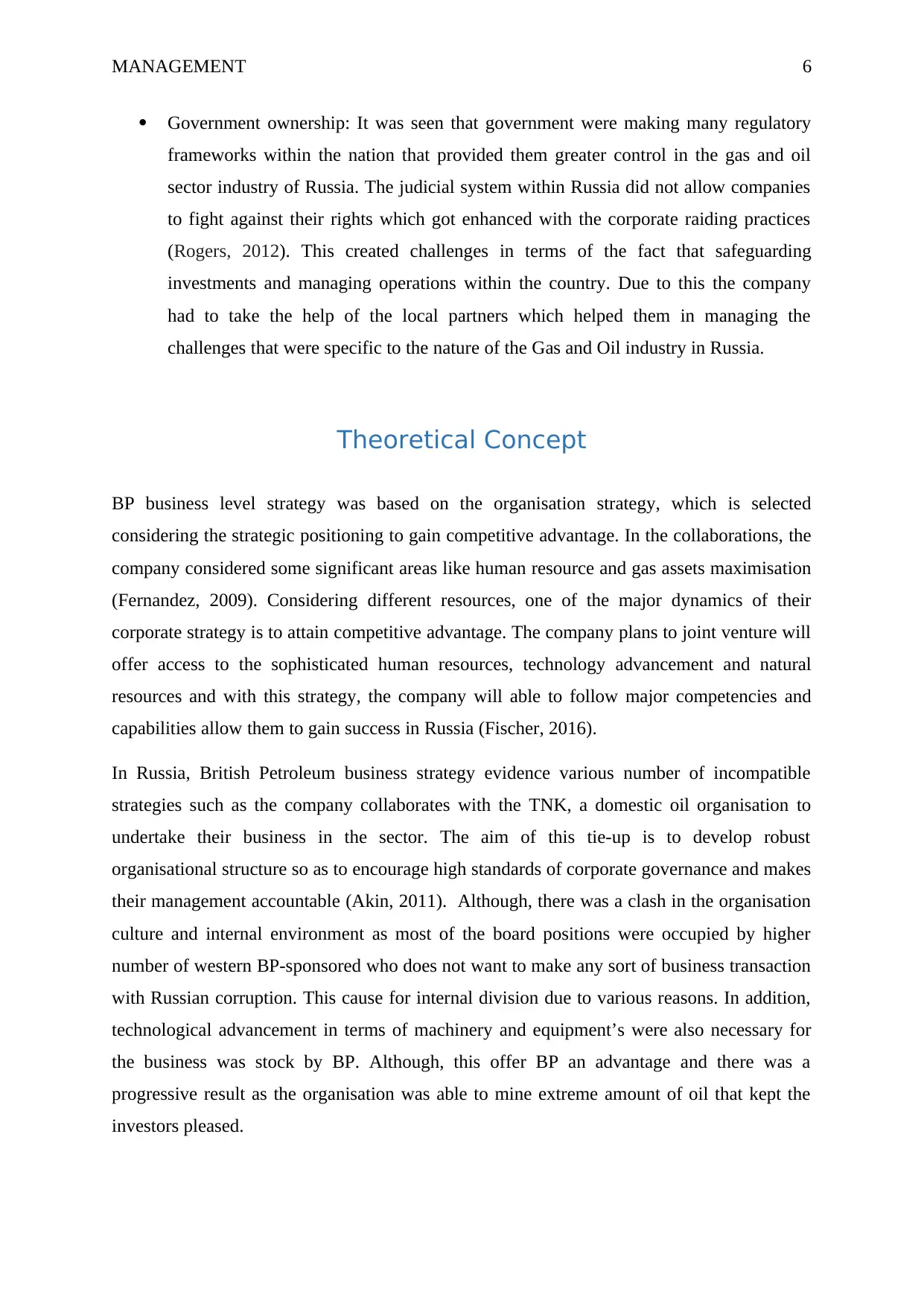
MANAGEMENT 6
Government ownership: It was seen that government were making many regulatory
frameworks within the nation that provided them greater control in the gas and oil
sector industry of Russia. The judicial system within Russia did not allow companies
to fight against their rights which got enhanced with the corporate raiding practices
(Rogers, 2012). This created challenges in terms of the fact that safeguarding
investments and managing operations within the country. Due to this the company
had to take the help of the local partners which helped them in managing the
challenges that were specific to the nature of the Gas and Oil industry in Russia.
Theoretical Concept
BP business level strategy was based on the organisation strategy, which is selected
considering the strategic positioning to gain competitive advantage. In the collaborations, the
company considered some significant areas like human resource and gas assets maximisation
(Fernandez, 2009). Considering different resources, one of the major dynamics of their
corporate strategy is to attain competitive advantage. The company plans to joint venture will
offer access to the sophisticated human resources, technology advancement and natural
resources and with this strategy, the company will able to follow major competencies and
capabilities allow them to gain success in Russia (Fischer, 2016).
In Russia, British Petroleum business strategy evidence various number of incompatible
strategies such as the company collaborates with the TNK, a domestic oil organisation to
undertake their business in the sector. The aim of this tie-up is to develop robust
organisational structure so as to encourage high standards of corporate governance and makes
their management accountable (Akin, 2011). Although, there was a clash in the organisation
culture and internal environment as most of the board positions were occupied by higher
number of western BP-sponsored who does not want to make any sort of business transaction
with Russian corruption. This cause for internal division due to various reasons. In addition,
technological advancement in terms of machinery and equipment’s were also necessary for
the business was stock by BP. Although, this offer BP an advantage and there was a
progressive result as the organisation was able to mine extreme amount of oil that kept the
investors pleased.
Government ownership: It was seen that government were making many regulatory
frameworks within the nation that provided them greater control in the gas and oil
sector industry of Russia. The judicial system within Russia did not allow companies
to fight against their rights which got enhanced with the corporate raiding practices
(Rogers, 2012). This created challenges in terms of the fact that safeguarding
investments and managing operations within the country. Due to this the company
had to take the help of the local partners which helped them in managing the
challenges that were specific to the nature of the Gas and Oil industry in Russia.
Theoretical Concept
BP business level strategy was based on the organisation strategy, which is selected
considering the strategic positioning to gain competitive advantage. In the collaborations, the
company considered some significant areas like human resource and gas assets maximisation
(Fernandez, 2009). Considering different resources, one of the major dynamics of their
corporate strategy is to attain competitive advantage. The company plans to joint venture will
offer access to the sophisticated human resources, technology advancement and natural
resources and with this strategy, the company will able to follow major competencies and
capabilities allow them to gain success in Russia (Fischer, 2016).
In Russia, British Petroleum business strategy evidence various number of incompatible
strategies such as the company collaborates with the TNK, a domestic oil organisation to
undertake their business in the sector. The aim of this tie-up is to develop robust
organisational structure so as to encourage high standards of corporate governance and makes
their management accountable (Akin, 2011). Although, there was a clash in the organisation
culture and internal environment as most of the board positions were occupied by higher
number of western BP-sponsored who does not want to make any sort of business transaction
with Russian corruption. This cause for internal division due to various reasons. In addition,
technological advancement in terms of machinery and equipment’s were also necessary for
the business was stock by BP. Although, this offer BP an advantage and there was a
progressive result as the organisation was able to mine extreme amount of oil that kept the
investors pleased.
Paraphrase This Document
Need a fresh take? Get an instant paraphrase of this document with our AI Paraphraser
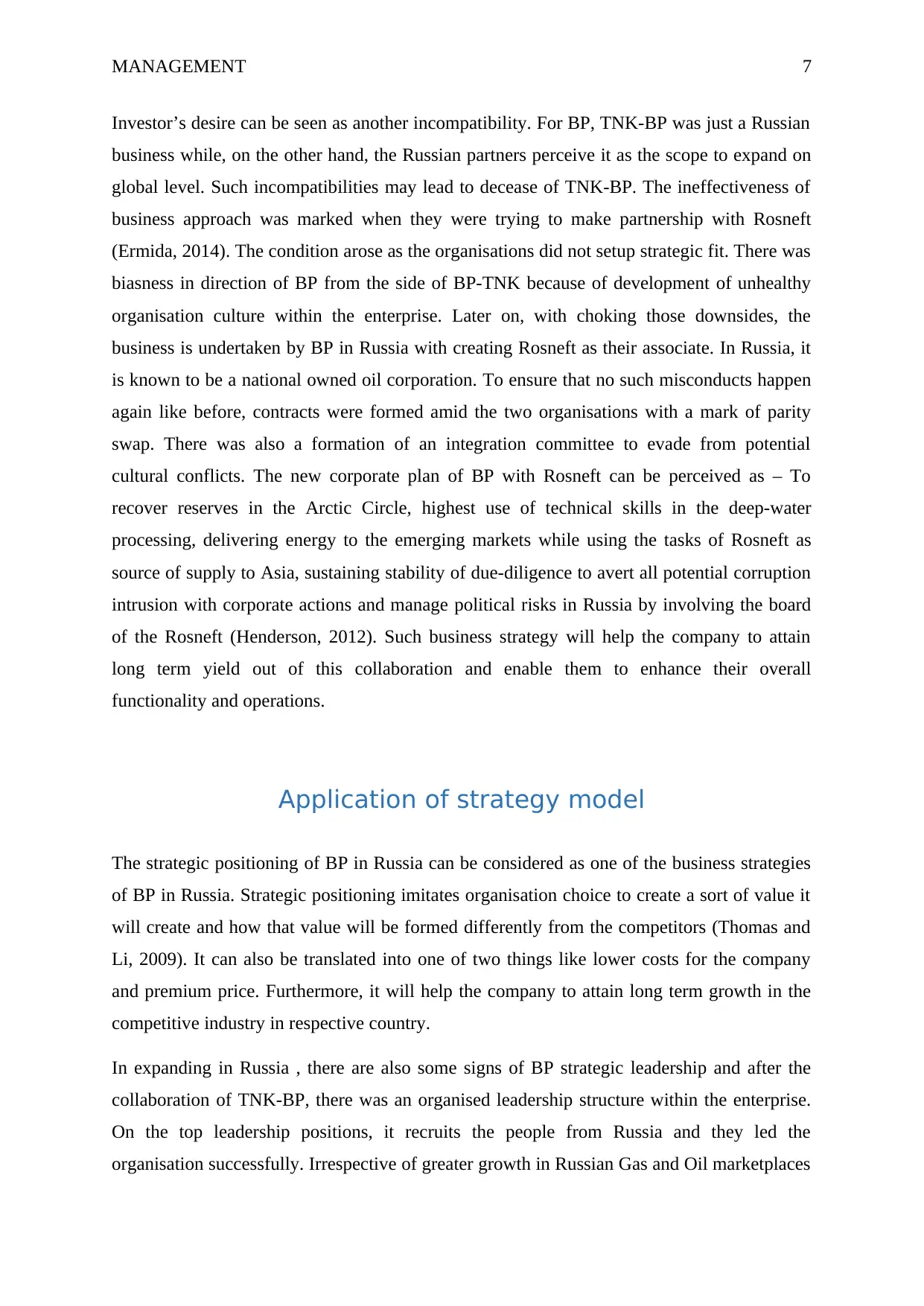
MANAGEMENT 7
Investor’s desire can be seen as another incompatibility. For BP, TNK-BP was just a Russian
business while, on the other hand, the Russian partners perceive it as the scope to expand on
global level. Such incompatibilities may lead to decease of TNK-BP. The ineffectiveness of
business approach was marked when they were trying to make partnership with Rosneft
(Ermida, 2014). The condition arose as the organisations did not setup strategic fit. There was
biasness in direction of BP from the side of BP-TNK because of development of unhealthy
organisation culture within the enterprise. Later on, with choking those downsides, the
business is undertaken by BP in Russia with creating Rosneft as their associate. In Russia, it
is known to be a national owned oil corporation. To ensure that no such misconducts happen
again like before, contracts were formed amid the two organisations with a mark of parity
swap. There was also a formation of an integration committee to evade from potential
cultural conflicts. The new corporate plan of BP with Rosneft can be perceived as – To
recover reserves in the Arctic Circle, highest use of technical skills in the deep-water
processing, delivering energy to the emerging markets while using the tasks of Rosneft as
source of supply to Asia, sustaining stability of due-diligence to avert all potential corruption
intrusion with corporate actions and manage political risks in Russia by involving the board
of the Rosneft (Henderson, 2012). Such business strategy will help the company to attain
long term yield out of this collaboration and enable them to enhance their overall
functionality and operations.
Application of strategy model
The strategic positioning of BP in Russia can be considered as one of the business strategies
of BP in Russia. Strategic positioning imitates organisation choice to create a sort of value it
will create and how that value will be formed differently from the competitors (Thomas and
Li, 2009). It can also be translated into one of two things like lower costs for the company
and premium price. Furthermore, it will help the company to attain long term growth in the
competitive industry in respective country.
In expanding in Russia , there are also some signs of BP strategic leadership and after the
collaboration of TNK-BP, there was an organised leadership structure within the enterprise.
On the top leadership positions, it recruits the people from Russia and they led the
organisation successfully. Irrespective of greater growth in Russian Gas and Oil marketplaces
Investor’s desire can be seen as another incompatibility. For BP, TNK-BP was just a Russian
business while, on the other hand, the Russian partners perceive it as the scope to expand on
global level. Such incompatibilities may lead to decease of TNK-BP. The ineffectiveness of
business approach was marked when they were trying to make partnership with Rosneft
(Ermida, 2014). The condition arose as the organisations did not setup strategic fit. There was
biasness in direction of BP from the side of BP-TNK because of development of unhealthy
organisation culture within the enterprise. Later on, with choking those downsides, the
business is undertaken by BP in Russia with creating Rosneft as their associate. In Russia, it
is known to be a national owned oil corporation. To ensure that no such misconducts happen
again like before, contracts were formed amid the two organisations with a mark of parity
swap. There was also a formation of an integration committee to evade from potential
cultural conflicts. The new corporate plan of BP with Rosneft can be perceived as – To
recover reserves in the Arctic Circle, highest use of technical skills in the deep-water
processing, delivering energy to the emerging markets while using the tasks of Rosneft as
source of supply to Asia, sustaining stability of due-diligence to avert all potential corruption
intrusion with corporate actions and manage political risks in Russia by involving the board
of the Rosneft (Henderson, 2012). Such business strategy will help the company to attain
long term yield out of this collaboration and enable them to enhance their overall
functionality and operations.
Application of strategy model
The strategic positioning of BP in Russia can be considered as one of the business strategies
of BP in Russia. Strategic positioning imitates organisation choice to create a sort of value it
will create and how that value will be formed differently from the competitors (Thomas and
Li, 2009). It can also be translated into one of two things like lower costs for the company
and premium price. Furthermore, it will help the company to attain long term growth in the
competitive industry in respective country.
In expanding in Russia , there are also some signs of BP strategic leadership and after the
collaboration of TNK-BP, there was an organised leadership structure within the enterprise.
On the top leadership positions, it recruits the people from Russia and they led the
organisation successfully. Irrespective of greater growth in Russian Gas and Oil marketplaces
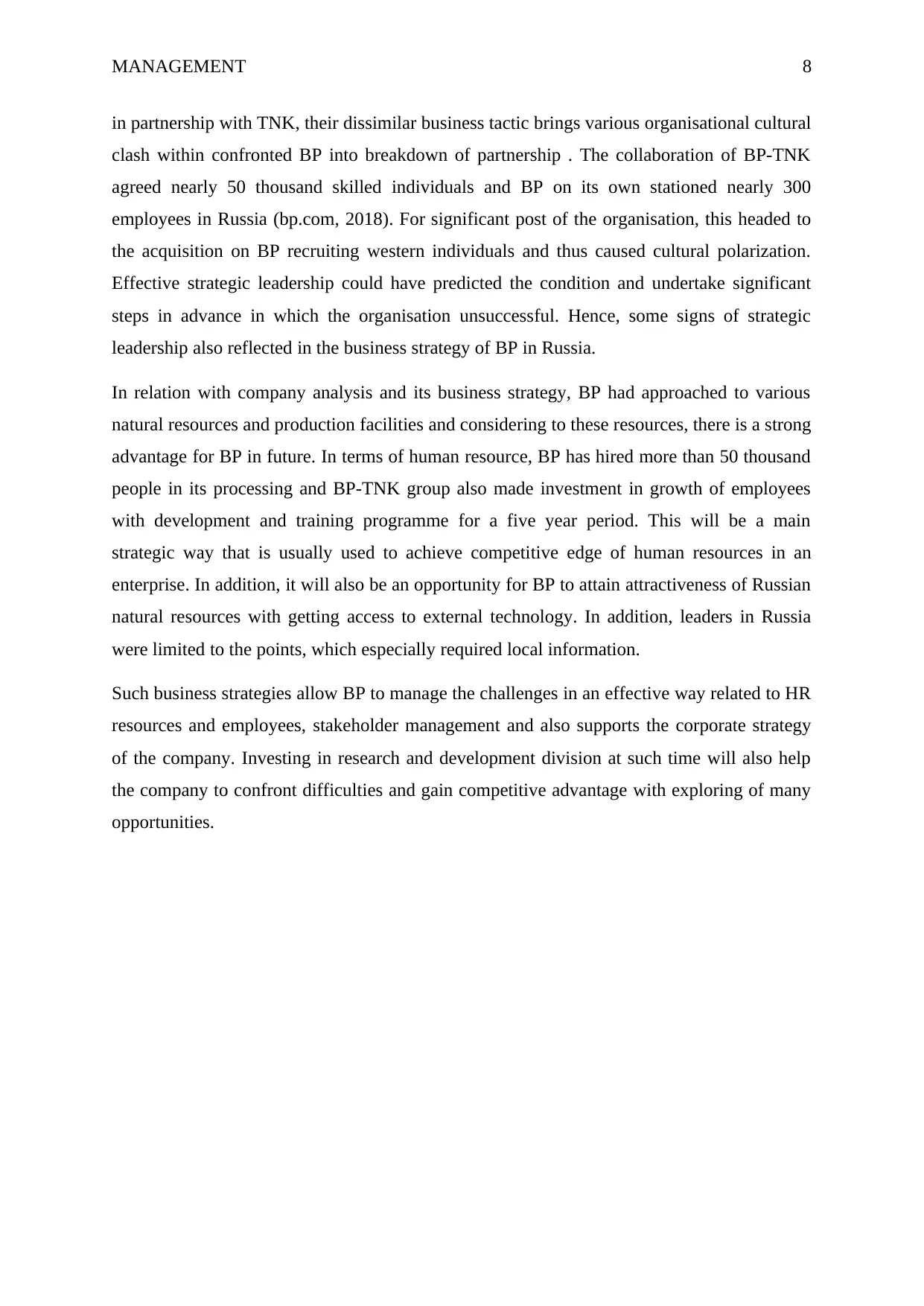
MANAGEMENT 8
in partnership with TNK, their dissimilar business tactic brings various organisational cultural
clash within confronted BP into breakdown of partnership . The collaboration of BP-TNK
agreed nearly 50 thousand skilled individuals and BP on its own stationed nearly 300
employees in Russia (bp.com, 2018). For significant post of the organisation, this headed to
the acquisition on BP recruiting western individuals and thus caused cultural polarization.
Effective strategic leadership could have predicted the condition and undertake significant
steps in advance in which the organisation unsuccessful. Hence, some signs of strategic
leadership also reflected in the business strategy of BP in Russia.
In relation with company analysis and its business strategy, BP had approached to various
natural resources and production facilities and considering to these resources, there is a strong
advantage for BP in future. In terms of human resource, BP has hired more than 50 thousand
people in its processing and BP-TNK group also made investment in growth of employees
with development and training programme for a five year period. This will be a main
strategic way that is usually used to achieve competitive edge of human resources in an
enterprise. In addition, it will also be an opportunity for BP to attain attractiveness of Russian
natural resources with getting access to external technology. In addition, leaders in Russia
were limited to the points, which especially required local information.
Such business strategies allow BP to manage the challenges in an effective way related to HR
resources and employees, stakeholder management and also supports the corporate strategy
of the company. Investing in research and development division at such time will also help
the company to confront difficulties and gain competitive advantage with exploring of many
opportunities.
in partnership with TNK, their dissimilar business tactic brings various organisational cultural
clash within confronted BP into breakdown of partnership . The collaboration of BP-TNK
agreed nearly 50 thousand skilled individuals and BP on its own stationed nearly 300
employees in Russia (bp.com, 2018). For significant post of the organisation, this headed to
the acquisition on BP recruiting western individuals and thus caused cultural polarization.
Effective strategic leadership could have predicted the condition and undertake significant
steps in advance in which the organisation unsuccessful. Hence, some signs of strategic
leadership also reflected in the business strategy of BP in Russia.
In relation with company analysis and its business strategy, BP had approached to various
natural resources and production facilities and considering to these resources, there is a strong
advantage for BP in future. In terms of human resource, BP has hired more than 50 thousand
people in its processing and BP-TNK group also made investment in growth of employees
with development and training programme for a five year period. This will be a main
strategic way that is usually used to achieve competitive edge of human resources in an
enterprise. In addition, it will also be an opportunity for BP to attain attractiveness of Russian
natural resources with getting access to external technology. In addition, leaders in Russia
were limited to the points, which especially required local information.
Such business strategies allow BP to manage the challenges in an effective way related to HR
resources and employees, stakeholder management and also supports the corporate strategy
of the company. Investing in research and development division at such time will also help
the company to confront difficulties and gain competitive advantage with exploring of many
opportunities.
⊘ This is a preview!⊘
Do you want full access?
Subscribe today to unlock all pages.

Trusted by 1+ million students worldwide
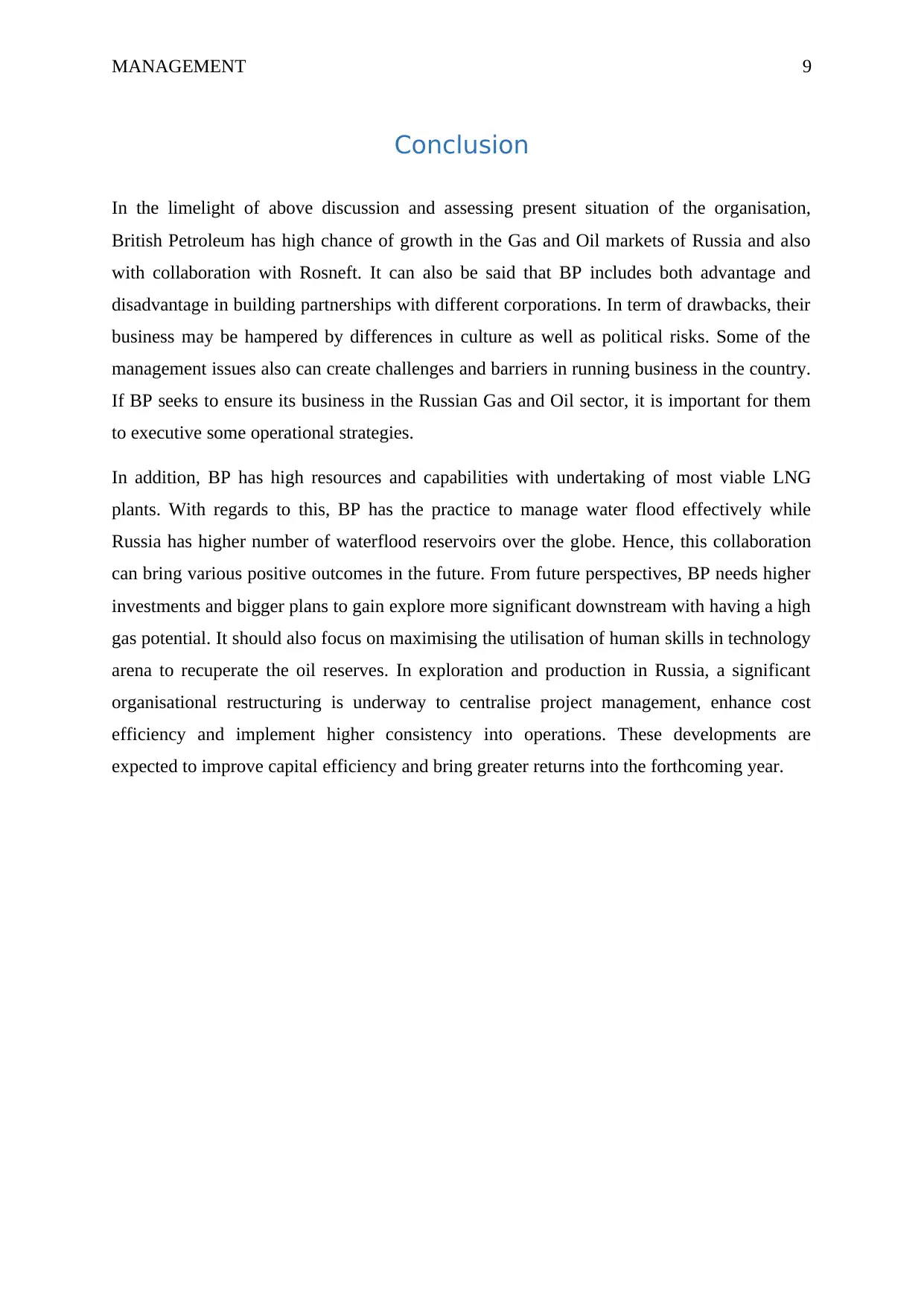
MANAGEMENT 9
Conclusion
In the limelight of above discussion and assessing present situation of the organisation,
British Petroleum has high chance of growth in the Gas and Oil markets of Russia and also
with collaboration with Rosneft. It can also be said that BP includes both advantage and
disadvantage in building partnerships with different corporations. In term of drawbacks, their
business may be hampered by differences in culture as well as political risks. Some of the
management issues also can create challenges and barriers in running business in the country.
If BP seeks to ensure its business in the Russian Gas and Oil sector, it is important for them
to executive some operational strategies.
In addition, BP has high resources and capabilities with undertaking of most viable LNG
plants. With regards to this, BP has the practice to manage water flood effectively while
Russia has higher number of waterflood reservoirs over the globe. Hence, this collaboration
can bring various positive outcomes in the future. From future perspectives, BP needs higher
investments and bigger plans to gain explore more significant downstream with having a high
gas potential. It should also focus on maximising the utilisation of human skills in technology
arena to recuperate the oil reserves. In exploration and production in Russia, a significant
organisational restructuring is underway to centralise project management, enhance cost
efficiency and implement higher consistency into operations. These developments are
expected to improve capital efficiency and bring greater returns into the forthcoming year.
Conclusion
In the limelight of above discussion and assessing present situation of the organisation,
British Petroleum has high chance of growth in the Gas and Oil markets of Russia and also
with collaboration with Rosneft. It can also be said that BP includes both advantage and
disadvantage in building partnerships with different corporations. In term of drawbacks, their
business may be hampered by differences in culture as well as political risks. Some of the
management issues also can create challenges and barriers in running business in the country.
If BP seeks to ensure its business in the Russian Gas and Oil sector, it is important for them
to executive some operational strategies.
In addition, BP has high resources and capabilities with undertaking of most viable LNG
plants. With regards to this, BP has the practice to manage water flood effectively while
Russia has higher number of waterflood reservoirs over the globe. Hence, this collaboration
can bring various positive outcomes in the future. From future perspectives, BP needs higher
investments and bigger plans to gain explore more significant downstream with having a high
gas potential. It should also focus on maximising the utilisation of human skills in technology
arena to recuperate the oil reserves. In exploration and production in Russia, a significant
organisational restructuring is underway to centralise project management, enhance cost
efficiency and implement higher consistency into operations. These developments are
expected to improve capital efficiency and bring greater returns into the forthcoming year.
Paraphrase This Document
Need a fresh take? Get an instant paraphrase of this document with our AI Paraphraser
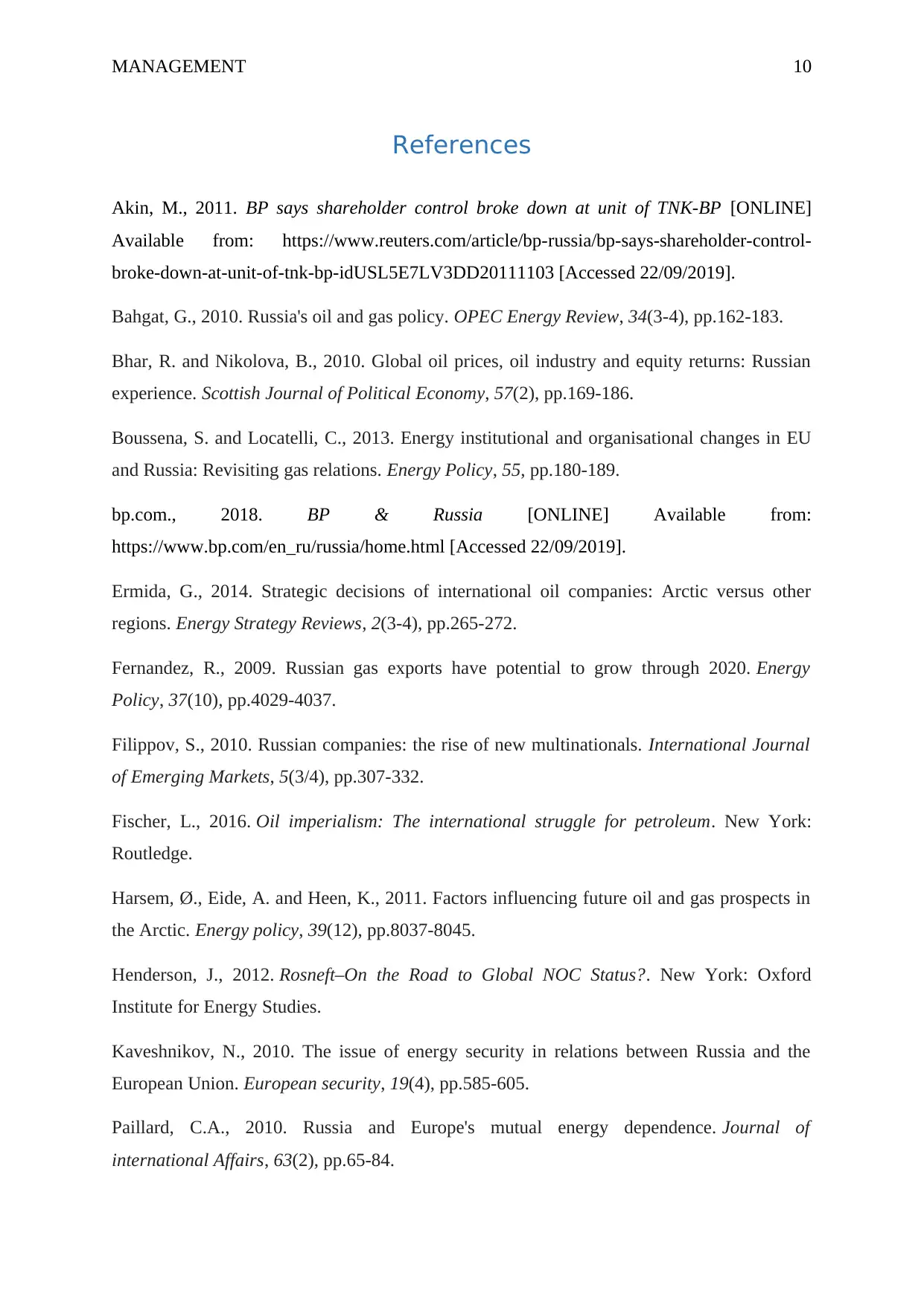
MANAGEMENT 10
References
Akin, M., 2011. BP says shareholder control broke down at unit of TNK-BP [ONLINE]
Available from: https://www.reuters.com/article/bp-russia/bp-says-shareholder-control-
broke-down-at-unit-of-tnk-bp-idUSL5E7LV3DD20111103 [Accessed 22/09/2019].
Bahgat, G., 2010. Russia's oil and gas policy. OPEC Energy Review, 34(3‐4), pp.162-183.
Bhar, R. and Nikolova, B., 2010. Global oil prices, oil industry and equity returns: Russian
experience. Scottish Journal of Political Economy, 57(2), pp.169-186.
Boussena, S. and Locatelli, C., 2013. Energy institutional and organisational changes in EU
and Russia: Revisiting gas relations. Energy Policy, 55, pp.180-189.
bp.com., 2018. BP & Russia [ONLINE] Available from:
https://www.bp.com/en_ru/russia/home.html [Accessed 22/09/2019].
Ermida, G., 2014. Strategic decisions of international oil companies: Arctic versus other
regions. Energy Strategy Reviews, 2(3-4), pp.265-272.
Fernandez, R., 2009. Russian gas exports have potential to grow through 2020. Energy
Policy, 37(10), pp.4029-4037.
Filippov, S., 2010. Russian companies: the rise of new multinationals. International Journal
of Emerging Markets, 5(3/4), pp.307-332.
Fischer, L., 2016. Oil imperialism: The international struggle for petroleum. New York:
Routledge.
Harsem, Ø., Eide, A. and Heen, K., 2011. Factors influencing future oil and gas prospects in
the Arctic. Energy policy, 39(12), pp.8037-8045.
Henderson, J., 2012. Rosneft–On the Road to Global NOC Status?. New York: Oxford
Institute for Energy Studies.
Kaveshnikov, N., 2010. The issue of energy security in relations between Russia and the
European Union. European security, 19(4), pp.585-605.
Paillard, C.A., 2010. Russia and Europe's mutual energy dependence. Journal of
international Affairs, 63(2), pp.65-84.
References
Akin, M., 2011. BP says shareholder control broke down at unit of TNK-BP [ONLINE]
Available from: https://www.reuters.com/article/bp-russia/bp-says-shareholder-control-
broke-down-at-unit-of-tnk-bp-idUSL5E7LV3DD20111103 [Accessed 22/09/2019].
Bahgat, G., 2010. Russia's oil and gas policy. OPEC Energy Review, 34(3‐4), pp.162-183.
Bhar, R. and Nikolova, B., 2010. Global oil prices, oil industry and equity returns: Russian
experience. Scottish Journal of Political Economy, 57(2), pp.169-186.
Boussena, S. and Locatelli, C., 2013. Energy institutional and organisational changes in EU
and Russia: Revisiting gas relations. Energy Policy, 55, pp.180-189.
bp.com., 2018. BP & Russia [ONLINE] Available from:
https://www.bp.com/en_ru/russia/home.html [Accessed 22/09/2019].
Ermida, G., 2014. Strategic decisions of international oil companies: Arctic versus other
regions. Energy Strategy Reviews, 2(3-4), pp.265-272.
Fernandez, R., 2009. Russian gas exports have potential to grow through 2020. Energy
Policy, 37(10), pp.4029-4037.
Filippov, S., 2010. Russian companies: the rise of new multinationals. International Journal
of Emerging Markets, 5(3/4), pp.307-332.
Fischer, L., 2016. Oil imperialism: The international struggle for petroleum. New York:
Routledge.
Harsem, Ø., Eide, A. and Heen, K., 2011. Factors influencing future oil and gas prospects in
the Arctic. Energy policy, 39(12), pp.8037-8045.
Henderson, J., 2012. Rosneft–On the Road to Global NOC Status?. New York: Oxford
Institute for Energy Studies.
Kaveshnikov, N., 2010. The issue of energy security in relations between Russia and the
European Union. European security, 19(4), pp.585-605.
Paillard, C.A., 2010. Russia and Europe's mutual energy dependence. Journal of
international Affairs, 63(2), pp.65-84.
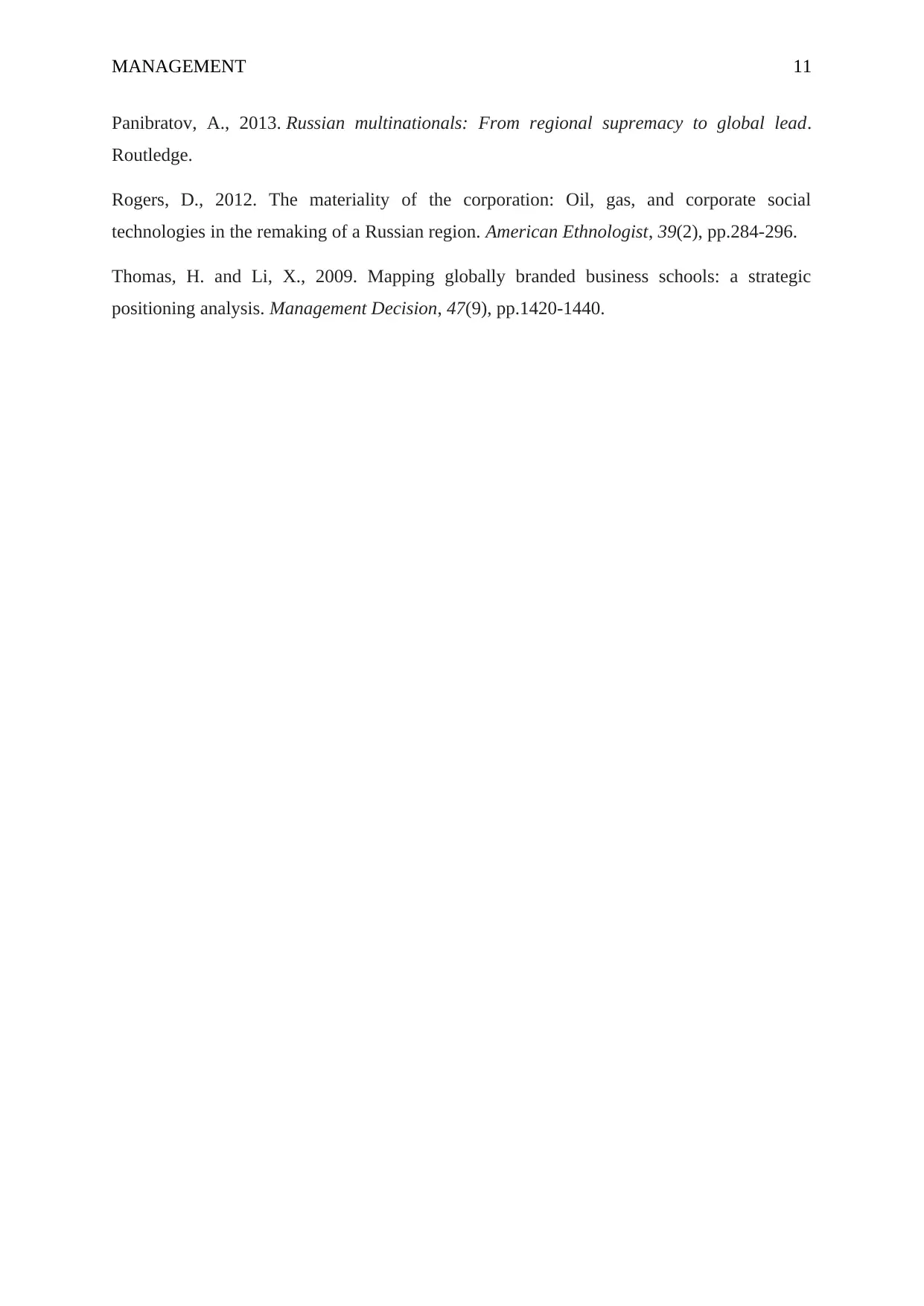
MANAGEMENT 11
Panibratov, A., 2013. Russian multinationals: From regional supremacy to global lead.
Routledge.
Rogers, D., 2012. The materiality of the corporation: Oil, gas, and corporate social
technologies in the remaking of a Russian region. American Ethnologist, 39(2), pp.284-296.
Thomas, H. and Li, X., 2009. Mapping globally branded business schools: a strategic
positioning analysis. Management Decision, 47(9), pp.1420-1440.
Panibratov, A., 2013. Russian multinationals: From regional supremacy to global lead.
Routledge.
Rogers, D., 2012. The materiality of the corporation: Oil, gas, and corporate social
technologies in the remaking of a Russian region. American Ethnologist, 39(2), pp.284-296.
Thomas, H. and Li, X., 2009. Mapping globally branded business schools: a strategic
positioning analysis. Management Decision, 47(9), pp.1420-1440.
⊘ This is a preview!⊘
Do you want full access?
Subscribe today to unlock all pages.

Trusted by 1+ million students worldwide
1 out of 13
Related Documents
Your All-in-One AI-Powered Toolkit for Academic Success.
+13062052269
info@desklib.com
Available 24*7 on WhatsApp / Email
![[object Object]](/_next/static/media/star-bottom.7253800d.svg)
Unlock your academic potential
Copyright © 2020–2025 A2Z Services. All Rights Reserved. Developed and managed by ZUCOL.




